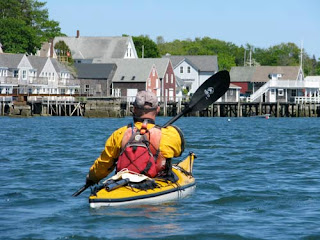
Vinalhaven, only about six miles across Penobscot Bay from Deer Isle, remains about as elusive to most Deer Isle residents as a distant continent. You can get there from here, but it requires either crossing a broad stretch of ocean in your own boat or driving a couple of hours to Rockland to take the ferry. We’re usually content to vaguely identify it as part of the dark mass of land along the western horizon, merging with North Haven and the Camden Hills. Last fall though, our sunset vista was altered by a trio of newly-constructed windmills on Vinalhaven, each standing nearly four-hundred feet tall, and the island crept further into our consciousness. When Todd and I made time for a five-day kayak excursion, we decided to take a closer look at Vinalhaven.
 The weather on Monday wasn’t great for the crossing: northwest wind in the mid-teens with higher gusts. Air and water temps in the mid to high forties. From the time we nosed out of the Thorofare until we pulled into Seal Bay, my boat weathercocked enough to keep me sweeping and leaning the entire time- an exhausting -and I hate to admit it- not terribly enjoyable paddle. Todd did better in his Solstice (even with the rudder removed). The five gallons of water I carried in the cockpit may have contributed to a problem with load distribution, but there wasn’t much I could do about it once we were underway.
The weather on Monday wasn’t great for the crossing: northwest wind in the mid-teens with higher gusts. Air and water temps in the mid to high forties. From the time we nosed out of the Thorofare until we pulled into Seal Bay, my boat weathercocked enough to keep me sweeping and leaning the entire time- an exhausting -and I hate to admit it- not terribly enjoyable paddle. Todd did better in his Solstice (even with the rudder removed). The five gallons of water I carried in the cockpit may have contributed to a problem with load distribution, but there wasn’t much I could do about it once we were underway.A cold, wet, tiring paddle, but other than that, pretty good. Nothing that a little miso soup on the Jetboil couldn’t cure.
 Highlights:
Highlights:-Little Hen Island: our first campsite, in Seal Bay. Mostly out of the wind on a night with frost warnings in the mid-thirties. At night, beyond the trees, the red lights of the windmills winked rythmically.
-Hugging the shore in a clockwise circumnavigation. Checking-out the coves and inlets on the way into town, where we tied-up at the public dock and ate ice-cream.

-Camping for two nights on an island west of Hurricane Sound, ambiguously referred to as Spectacle Island. Half the island was removed in the most destructive quarrying activity we’ve seen, but we camped in a less-touched, idyllic spot with a huge view of Pen Bay and the Camden Hills. Despite the cold, I slept with my tent flap open so I could see the lights of Camden and the clear points of stars above.

-A day trip around the White Islands and Little Hurricane Island, where we found just enough swell to make for some excitement among the rocks and waves.

At one point, I was stranded about as high and dry as I’ve been- a balancing act until a big wave set me free. Todd reached for the camera, then thought better and went for the tow belt, but I was out of reach. Toned it down a notch after that.

-The windmills, surprisingly big and close, again and again.

-The Basin, a large inlet surrounded by wild, protected land. The tide goes in and out of the basin through two small openings which develop strong currents with standing waves and boils. We went in, committing ourselves to a couple hours of exploration before the current reversed direction. Inside, we paddled among islands of glacial erratic boulders, watched over by ospreys and eagles. A small baby seal, only about a foot and a half long, swam right up to my cockpit whimpering like it was looking for its mother. Cute as it was, I kept paddling.

-The Fox Islands Thorofare. Wow. Impressive real estate. Hundred year-old summer residences overlooking an obstacle course of mooring balls, which I assume will soon be tethering all sorts of recreational vessels.

-North Haven. We peeled our drysuits down to our waists and took a walk through town, which felt quiet and friendly. People looked at us, but not in the “what the heck are you wearing?” sort of way. Almost everyone said hello. Had a coffee at Waterman’s Community Center and the friendly woman there was happy to answer all of Todd’s questions. Interesting, how the people on these different islands so close together develop such different social habits.

-Calderwood Island. A large land trust island managed by Maine Coast Heritage Trust. From our campsite on the east end, the water and microwave towers in Stonington were clearly visible, but still far enough to feel like another world. Five days, fifty miles, plenty of hanging-out on islands: a fairly relaxed way to start a not-so relaxed summer.












